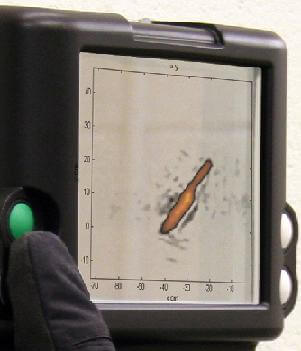X-Ray Vision: Handheld Radar Allows Army/Security To Look Inside Walls

Share
A portable device the the size of a textbook promises to give army and security personnel the x-ray vision of Superman...only without the x-rays. The prototype Sprint system, developed by Cambridge Consultants, uses short range radar to peer inside solid objects and produce a 3D image of the interior on its display screen. Place the Sprint against a wall and you'll be able to see embedded objects such as pipes, cables...or bombs. With the growing focus on asymmetric warfare and terrorism tactics shaping our international security needs, Sprint could prove to be a very desirable device for inspectors everywhere. It's one of the many advanced sensor technologies that are likely to become a large part of the security systems of the future.
The big advantage that the Sprint prototype has over many other detection scanners available on the market is that it is portable. Low-grade x-ray scanners, or infrared imaging systems like you see in the airport require objects to fit inside them. Spring can be brought anywhere. Not only that, but it doesn't require you to place a receiver on the opposite end of the scanner. You can look at objects from just one side (another big advantage over other devices). For many construction materials, Sprint should work like a magic window. Place it against a wall, floor, and ceiling, and you can look inside.
Yet for those who envision some sort of Hollywood-inspired gadget that let's you see cartoonish outlines of hidden objects, think again. Short range radar works by sending pulses of electromagnetic waves and measuring how they reflect back to the transmitter. The resulting images are more like ultrasound pregnancy scans than they are the x-ray screens from Looney Toons. Armed with Sprint, security personnel should be able to tell the difference between an electrical cable that runs inside a wall and a small metal box that might be an explosive device. That level of detection should be more than enough to make the Sprint a worthwhile addition to security forces around the world.
As Cambridge Consultants only recently announced the production of Sprint, there are still some questions left unanswered. Sprint has been described by its makers as a safe, cheap, and quick low power device, but its pricetag hasn't been announced yet, nor its battery life, or scan times. This being a prototype, we also have no idea when it will actually be available for use (though Cambridge Consultants make references in their press release to applications for the 2012 London Olympics). It's too early to know if Sprint will end up being the real deal, or just another interesting anti-terrorism concept.
Of course, Cambridge Consultant has demonstrated some pretty handy radar based technology in the past that's proven itself in the field. The Prism is a handheld short range radar device that allows you to see rough images of moving objects behind a wall up to 20 meters. It's been around since 2005, and adopted by various military and police agencies in the field. My guess is that Sprint will prove likewise successful as it's based on complimentary technology.
Be Part of the Future
Sign up to receive top stories about groundbreaking technologies and visionary thinkers from SingularityHub.


No matter what the fate of the Sprint prototype, the field of security sensing as a whole will continue to move forward and I think this device shows that our traditional understanding of what can be accomplished needs to be updated. A few years ago the idea that a full body scanner that would allow someone to see the dimples in your skin without having to remove your clothes would have seem extraordinary. Now such systems are in many major airports. Short range scanners like Sprint and Prism are going to allow us to quickly peer inside and through walls. Other technologies may one day do the same for your brain. These developments may help keep us safer but they'll also raise issues of privacy as we adjust to new ideas of what people can learn about us just by peering through their magic windows. Ah well, even Superman had to face the occasional moral conundrum.
[image credits: Cambridge Consultants]
Sources: cambridge consultants
Related Articles

This Portable Wind Turbine Is the Size of a Water Bottle and Charges Devices in Under an Hour

Mojo Vision’s New Contact Lens Brings Seamless Augmented Reality a Step Closer
The Weird, the Wacky, the Just Plain Cool: Best of CES 2020
What we’re reading


